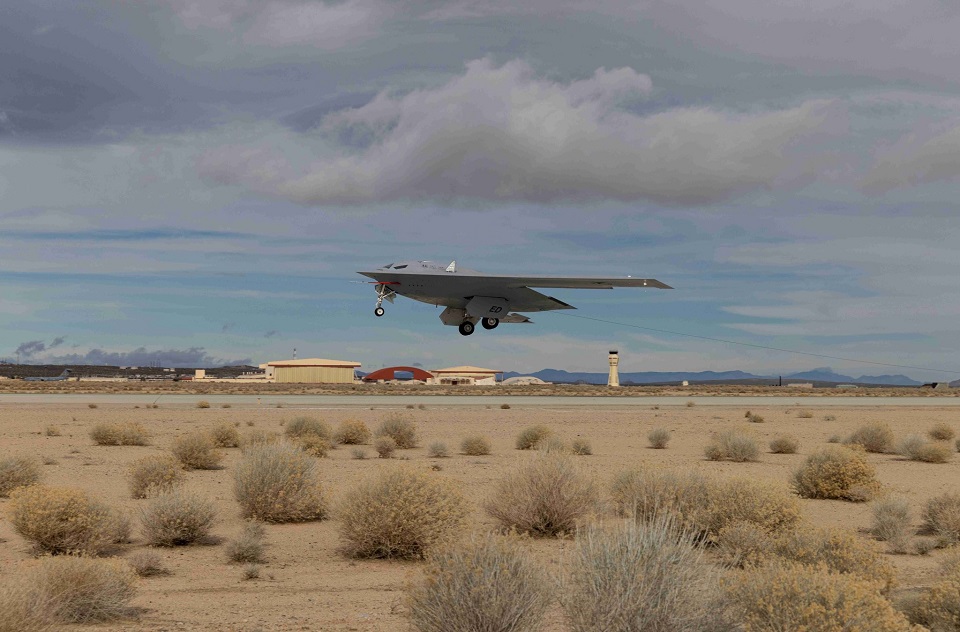Aerospace
Take First Glimpse of USAF B-21 Raider, Latest Nuclear Stealth Bomber

The United States Air Force (USAF) has unveiled the first photographs of the Northrop Grumman B-21 Raider bomber in flight.
These images were captured during test flights conducted by the B-21 Combined Test Force at Edwards Air Force Base, marking a significant milestone in the development of this sixth-generation aircraft.
Currently undergoing flight tests in California, the B-21 Raider represents the next generation of stealth bombers. With an estimated cost of around $700 million per aircraft, the B-21 Raider is poised to become a crucial component of the USAF’s arsenal for conventional Long Range Strike missions.
According to Air Force briefings, the B-21 Raider will form part of a comprehensive family of systems, encompassing Intelligence, Surveillance, and Reconnaissance capabilities, electronic warfare, communication systems, and more. Notably, the bomber will be nuclear-capable and adaptable for both manned and unmanned operations.
It boasts the flexibility to deploy a wide array of stand-off and direct-attack munitions, ensuring versatility in various combat scenarios. One of the B-21’s distinguishing features is its extensive integration of digital technology, as highlighted in discussions held during a Senate Armed Services Committee hearing.
Designed with an open systems architecture, the B-21 Raider is built to swiftly incorporate emerging technologies, ensuring its effectiveness against evolving threats over time. The B-21 Raider is slated to replace the aging B-1 Lancer and B-2 Spirit bombers, bolstering US national security objectives and providing reassurance to allies and partners worldwide.

Aerospace
When Ratan Tata was denied entry to the airfield at the Aero India show, he waited

During our visit to Aero India 2019, we had the unexpected opportunity to see Ratan Tata at the event, which was a thrilling moment for us. However, there was a surprising hiccup when the security staff didn’t allow him to enter due to a lack of a security pass.
Despite this, he remained calm and patiently waited for about 20 minutes until a member of the Tata team brought him the required pass, after which he calmly proceeded inside. It was a humbling sight, showcasing his composed demeanor even in such situations.
Ratan Tata ji is not only a renowned industrialist but also a trained pilot, holding a pilot’s license. In 2007, he became the first Indian civilian to fly the F-16 Falcon during the Aero India show in Bangalore—a proud moment for the nation.
His passion for aviation extended beyond flying, as he played a key role in shaping India’s aerospace industry. Under his leadership, Tata ventured into manufacturing and maintaining aerospace components while upholding its legacy of quality. Notably, Tata’s collaboration with Airbus to develop and manufacture the C295 aircraft is a testament to its growing influence in the sector.
-

 Aviation2 months ago
Aviation2 months agoMicrosoft Flight Simulator Raises $3 Million to Bring Back the An-225 Mriya
-

 Airlines2 months ago
Airlines2 months agoQantas Engineers Stage Walkout Over Cost of Living Concerns
-

 Airlines2 months ago
Airlines2 months agoQatar Citizens Can Travel to the United States Without a Visa
-

 Aviation2 months ago
Aviation2 months agoQatar Airways bans these new Electronic Devices on plane
-

 Airlines2 months ago
Airlines2 months agoJapan Airlines Rolls Out Free Domestic Flights to International Passengers
-

 Defence2 months ago
Defence2 months agoWhich Country Has the Largest Fleet of Fighter Aircraft?
-

 Airport2 months ago
Airport2 months agoWestern Sydney Airport Welcomes Its First Plane After 6 Years of construction
-

 Travel2 months ago
Travel2 months agoQatar Airways Launches Four Additional Flights from Amsterdam








